Citroen C4 RHD 2014 2.G Owner's Manual
Manufacturer: CITROEN, Model Year: 2014, Model line: C4 RHD, Model: Citroen C4 RHD 2014 2.GPages: 328
Page 191 of 328
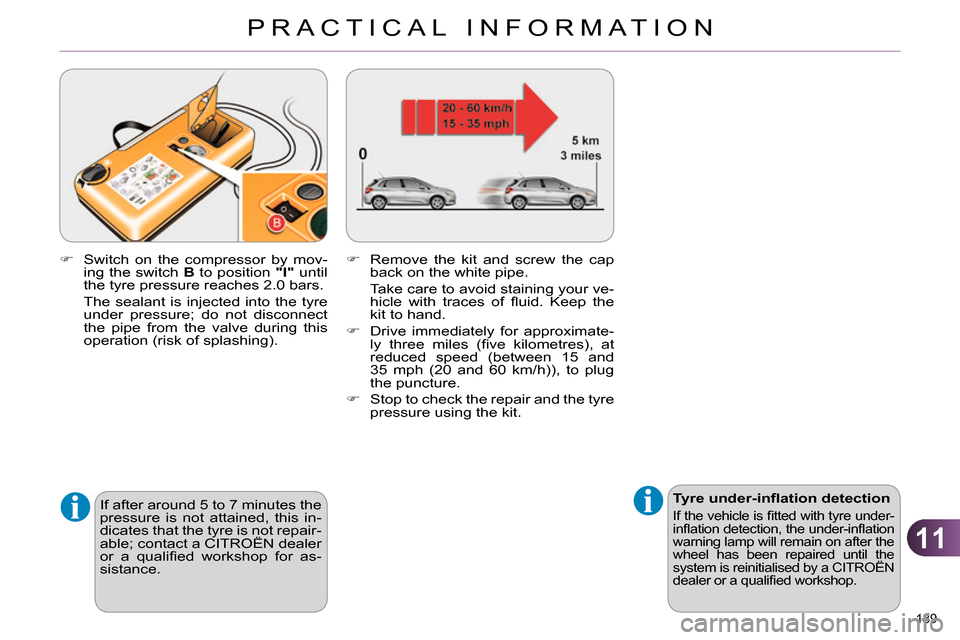
11
PRACTICAL INFORMATION
189
Tyre under-infl ation detection
If the vehicle is fi tted with tyre under-
infl ation detection, the under-infl ation
warning lamp will remain on after the
wheel has been repaired until the
system is reinitialised by a CITROËN
dealer or a qualifi ed workshop.
If after around 5 to 7 minutes the
pressure is not attained, this in-
dicates that the tyre is not repair-
able; contact a CITROËN dealer
or a qualifi ed workshop for as-
sistance.
Switch on the compressor by mov-
ing the switch B
to position "I"
until
the tyre pressure reaches 2.0 bars.
The sealant is injected into the tyre
under pressure; do not disconnect
the pipe from the valve during this
operation (risk of splashing).
Remove the kit and screw the cap
back on the white pipe.
Take care to avoid staining your ve-
hicle with traces of fl uid. Keep the
kit to hand.
Drive immediately for approximate-
ly three miles (fi ve kilometres), at
reduced speed (between 15 and
35 mph (20 and 60 km/h)), to plug
the puncture.
Stop to check the repair and the tyre
pressure using the kit.
Page 192 of 328
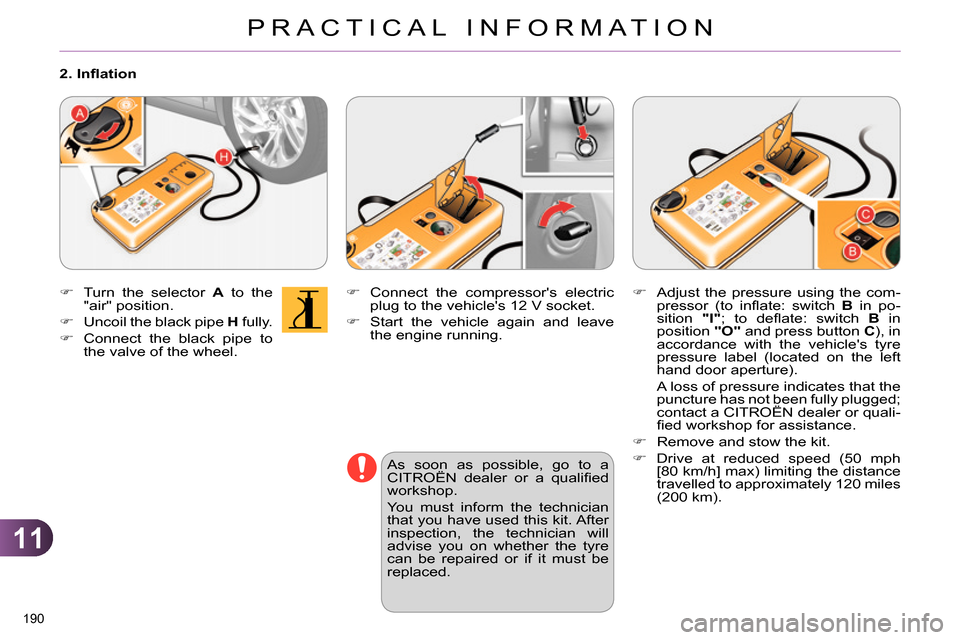
11
PRACTICAL INFORMATION
190
Connect the compressor's electric
plug to the vehicle's 12 V socket.
Start the vehicle again and leave
the engine running.
As soon as possible, go to a
CITROËN dealer or a qualifi ed
workshop.
You must inform the technician
that you have used this kit. After
inspection, the technician will
advise you on whether the tyre
can be repaired or if it must be
replaced.
Turn the selector A
to the
"air" position.
Uncoil the black pipe H
fully.
Connect the black pipe to
the valve of the wheel.
2. Infl ation
Adjust the pressure using the com-
pressor (to infl ate: switch B
in po-
sition "I"
; to defl ate: switch B
in
position "O"
and press button C
), in
accordance with the vehicle's tyre
pressure label (located on the left
hand door aperture).
A loss of pressure indicates that the
puncture has not been fully plugged;
contact a CITROËN dealer or quali-
fi ed workshop for assistance.
Remove and stow the kit.
Drive at reduced speed (50 mph
[80 km/h] max) limiting the distance
travelled to approximately 120 miles
(200 km).
Page 193 of 328
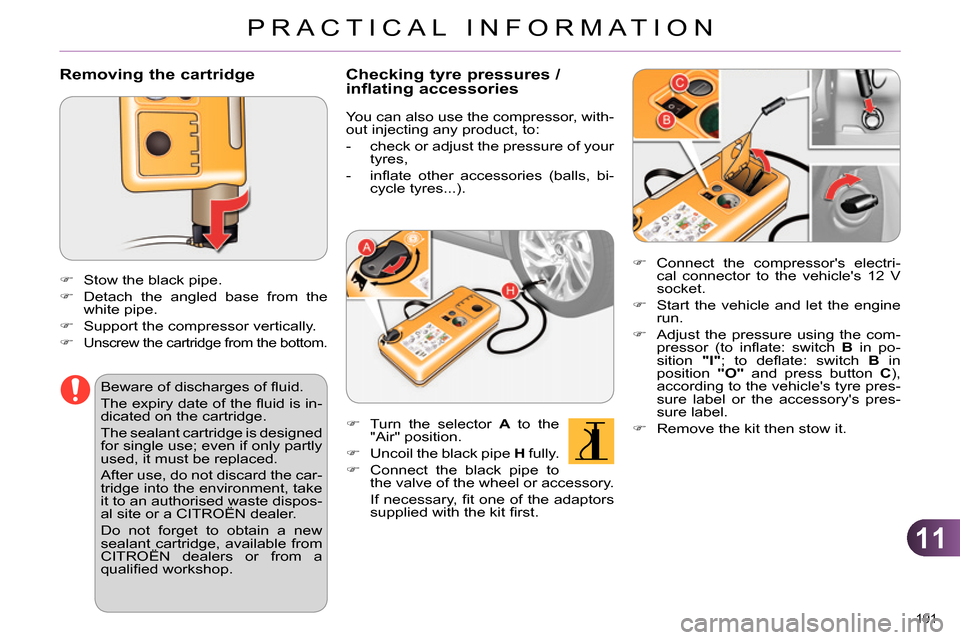
11
PRACTICAL INFORMATION
191
Removing the cartridge
Stow the black pipe.
Detach the angled base from the
white pipe.
Support the compressor vertically.
Unscrew the cartridge from the bottom.
Connect the compressor's electri-
cal connector to the vehicle's 12 V
socket.
Start the vehicle and let the engine
run.
Adjust the pressure using the com-
pressor (to infl ate: switch B
in po-
sition "I"
; to defl ate: switch B
in
position "O"
and press button C
),
according to the vehicle's tyre pres-
sure label or the accessory's pres-
sure label.
Remove the kit then stow it.
Beware of discharges of fl uid.
The expiry date of the fl uid is in-
dicated on the cartridge.
The sealant cartridge is designed
for single use; even if only partly
used, it must be replaced.
After use, do not discard the car-
tridge into the environment, take
it to an authorised waste dispos-
al site or a CITROËN dealer.
Do not forget to obtain a new
sealant cartridge, available from
CITROËN dealers or from a
qualifi ed workshop.
Checking tyre pressures /
inflating accessories
You can also use the compressor, with-
out injecting any product, to:
- check or adjust the pressure of your
tyres,
- infl ate other accessories (balls, bi-
cycle tyres...).
Turn the selector A
to the
"Air" position.
Uncoil the black pipe H
fully.
Connect the black pipe to
the valve of the wheel or accessory.
If necessary, fi t one of the adaptors
supplied with the kit fi rst.
Page 194 of 328

11
PRACTICAL INFORMATION
192
CHANGING A WHEEL
Procedure for changing a faulty wheel
for the spare wheel using the tools pro-
vided with the vehicle.
Access to the tools
The tools are installed in the boot under
the fl oor.
To gain access to them:
open the boot,
raise the fl oor,
secure it by hooking its cord on the
hook on the rear shelf support,
with a standard size spare wheel,
unclip and remove the box in the
middle of the wheel containing the
tools,
or
with a "space-saver" spare wheel;
lift the wheel at the rear towards you
for access to the storage box con-
taining the tools.
List of tools
All of these tools are specifi c to your
vehicle. Do not use them for other pur-
poses.
1.
Wheelbrace.
For removing the wheel trim and
the wheel fi xing bolts.
2.
Jack with integral handle.
For raising the vehicle.
3.
"Bolt cover" tool.
For removing the bolt protectors
(covers) on alloy wheels.
4.
Socket for the security bolts (lo-
cated in the glove box).
For adapting the wheelbrace to the
special "security" bolts.
Wheel with trim
When removing the wheel
, detach the trim fi rst using the wheelbrace 1
pulling at the valve passage hole.
When refi tting the wheel
, refi t the trim starting by placing its notch facing
the valve and press around its edge with the palm of your hand.
Page 195 of 328

11
PRACTICAL INFORMATION
193
Access to the spare wheel
The spare wheel is installed in the boot
under the fl oor.
Depending on version, the spare wheel
may be a standard size steel or alloy
wheel, or for some countries it is the
"space saver" type.
For access to the spare wheel, refer to
the paragraph "Access to the tools" on
the previous page.
Putting the standard wheel back in
place
Put the wheel back in its housing.
Unscrew the yellow central bolt by a
few turns then put it in place in the
centre of the wheel.
Tighten fully until the central bolt
clicks to retain the wheel correctly.
Tyre under-infl ation detection
The spare wheel is not fi tted with
a sensor. The punctured wheel
must be repaired by a CITROËN
dealer or aqualifi ed workshop.
Taking out the standard wheel
Unscrew the yellow central bolt.
Raise the spare wheel towards you
from the rear.
Take the wheel out of the boot.
Put the box back in place in the cen-
tre of the wheel and clip it.
If your vehicle has an electric
parking brake, only a space sav-
er wheel can be stowed in the
boot.
Page 196 of 328
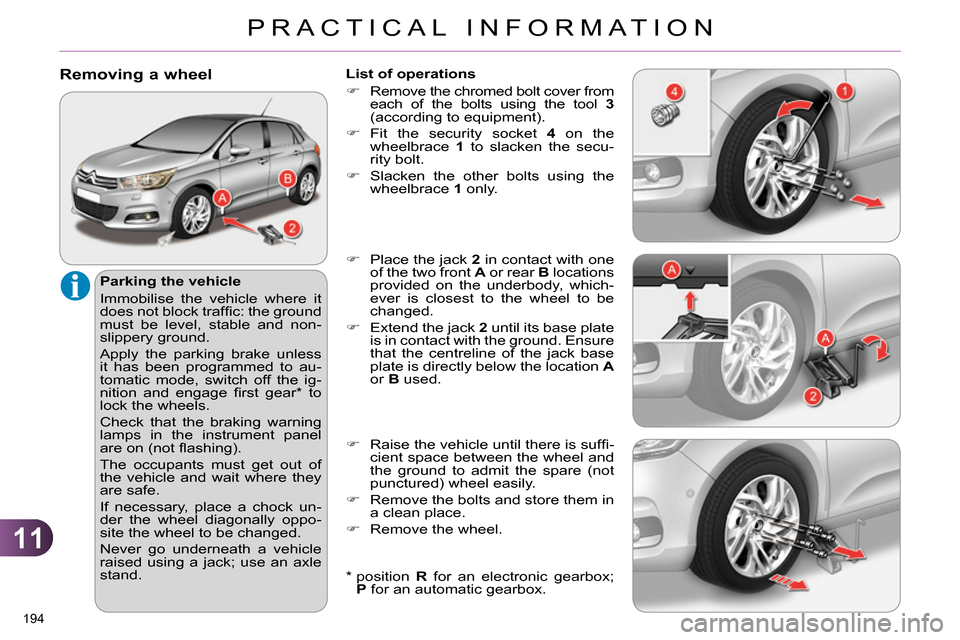
11
PRACTICAL INFORMATION
194
Removing a wheel
Parking the vehicle
Immobilise the vehicle where it
does not block traffi c: the ground
must be level, stable and non-
slippery ground.
Apply the parking brake unless
it has been programmed to au-
tomatic mode, switch off the ig-
nition and engage fi rst gear * to
lock the wheels.
Check that the braking warning
lamps in the instrument panel
are on (not fl ashing).
The occupants must get out of
the vehicle and wait where they
are safe.
If necessary, place a chock un-
der the wheel diagonally oppo-
site the wheel to be changed.
Never go underneath a vehicle
raised using a jack; use an axle
stand.
*
position R
for an electronic gearbox;
P
for an automatic gearbox.
List of operations
Remove the chromed bolt cover from
each of the bolts using the tool 3
(according to equipment).
Fit the security socket 4
on the
wheelbrace 1
to slacken the secu-
rity bolt.
Slacken the other bolts using the
wheelbrace 1
only.
Place the jack 2
in contact with one
of the two front A
or rear B
locations
provided on the underbody, which-
ever is closest to the wheel to be
changed.
Extend the jack 2
until its base plate
is in contact with the ground. Ensure
that the centreline of the jack base
plate is directly below the location A
or B
used.
Raise the vehicle until there is suffi -
cient space between the wheel and
the ground to admit the spare (not
punctured) wheel easily.
Remove the bolts and store them in
a clean place.
Remove the wheel.
Page 197 of 328
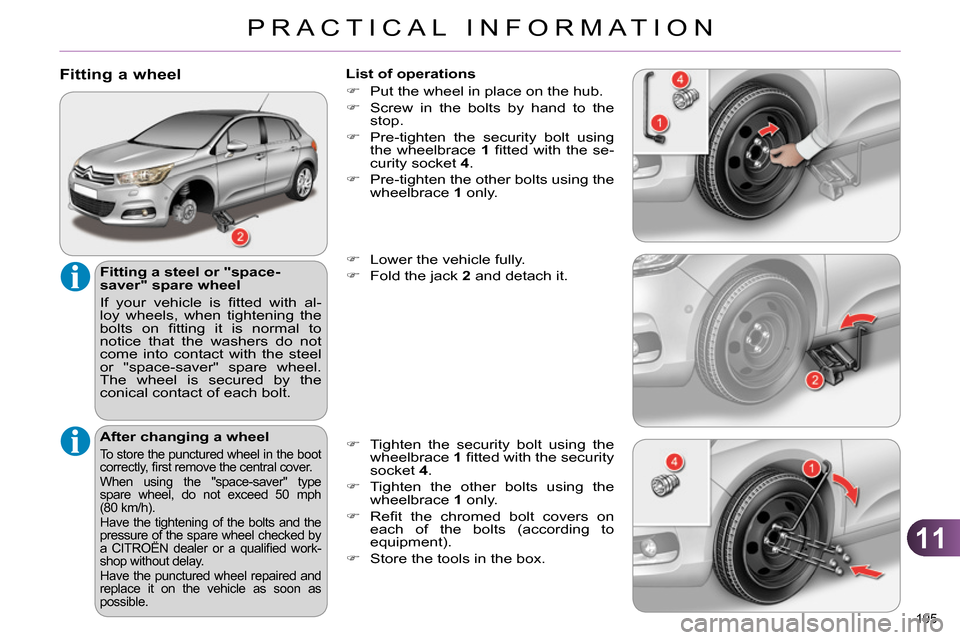
11
PRACTICAL INFORMATION
195
Fitting a wheel
Fitting a steel or "space-
saver" spare wheel
If your vehicle is fi tted with al-
loy wheels, when tightening the
bolts on fi tting it is normal to
notice that the washers do not
come into contact with the steel
or "space-saver" spare wheel.
The wheel is secured by the
conical contact of each bolt.
After changing a wheel
To store the punctured wheel in the boot
correctly, fi rst remove the central cover.
When using the "space-saver" type
spare wheel, do not exceed 50 mph
(80 km/h).
Have the tightening of the bolts and the
pressure of the spare wheel checked by
a CITROËN dealer or a qualifi ed work-
shop without delay.
Have the punctured wheel repaired and
replace it on the vehicle as soon as
possible.
List of operations
Put the wheel in place on the hub.
Screw in the bolts by hand to the
stop.
Pre-tighten the security bolt using
the wheelbrace 1
fi tted with the se-
curity socket 4
.
Pre-tighten the other bolts using the
wheelbrace 1
only.
Lower the vehicle fully.
Fold the jack 2
and detach it.
Tighten the security bolt using the
wheelbrace 1
fi tted with the security
socket 4
.
Tighten the other bolts using the
wheelbrace 1
only.
Refi t the chromed bolt covers on
each of the bolts (according to
equipment).
Store the tools in the box.
Page 198 of 328
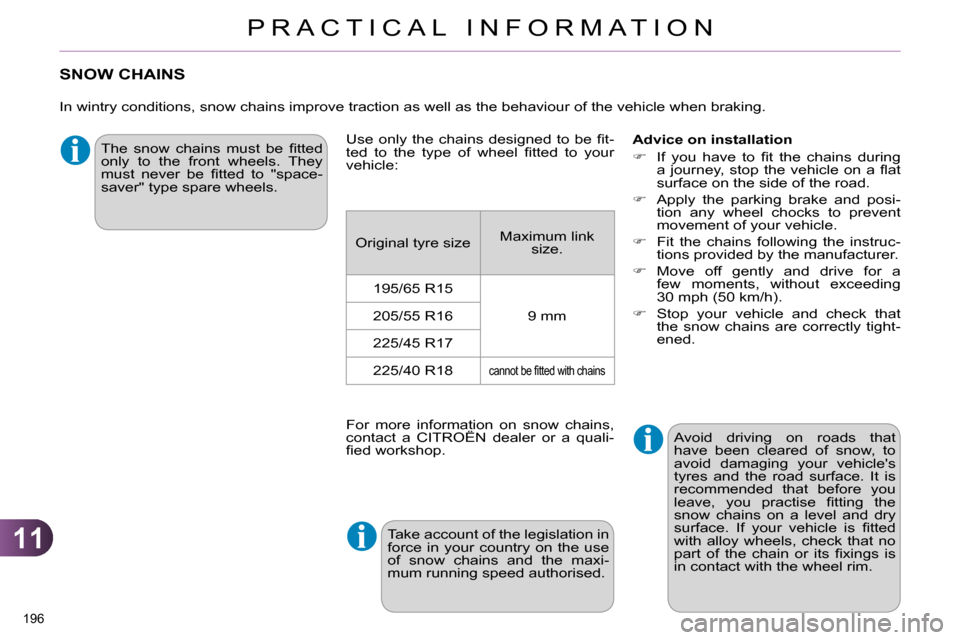
11
PRACTICAL INFORMATION
196
SNOW CHAINS
In wintry conditions, snow chains improve traction as well as the behaviour of the vehicle when braking.
Advice on installation
If you have to fi t the chains during
a journey, stop the vehicle on a fl at
surface on the side of the road.
Apply the parking brake and posi-
tion any wheel chocks to prevent
movement of your vehicle.
Fit the chains following the instruc-
tions provided by the manufacturer.
Move off gently and drive for a
few moments, without exceeding
30 mph (50 km/h).
Stop your vehicle and check that
the snow chains are correctly tight-
ened.
The snow chains must be fi tted
only to the front wheels. They
must never be fi tted to "space-
saver" type spare wheels.
Take account of the legislation in
force in your country on the use
of snow chains and the maxi-
mum running speed authorised.
Avoid driving on roads that
have been cleared of snow, to
avoid damaging your vehicle's
tyres and the road surface. It is
recommended that before you
leave, you practise fi tting the
snow chains on a level and dry
surface. If your vehicle is fi tted
with alloy wheels, check that no
part of the chain or its fi xings is
in contact with the wheel rim.
Use only the chains designed to be fi t-
ted to the type of wheel fi tted to your
vehicle:
Original tyre size Maximum link
size.
195/65 R15
9 mm
205/55 R16
225/45 R17
225/40 R18
cannot be fi tted with chains
For more information on snow chains,
contact a CITROËN dealer or a quali-
fi ed workshop.
Page 199 of 328
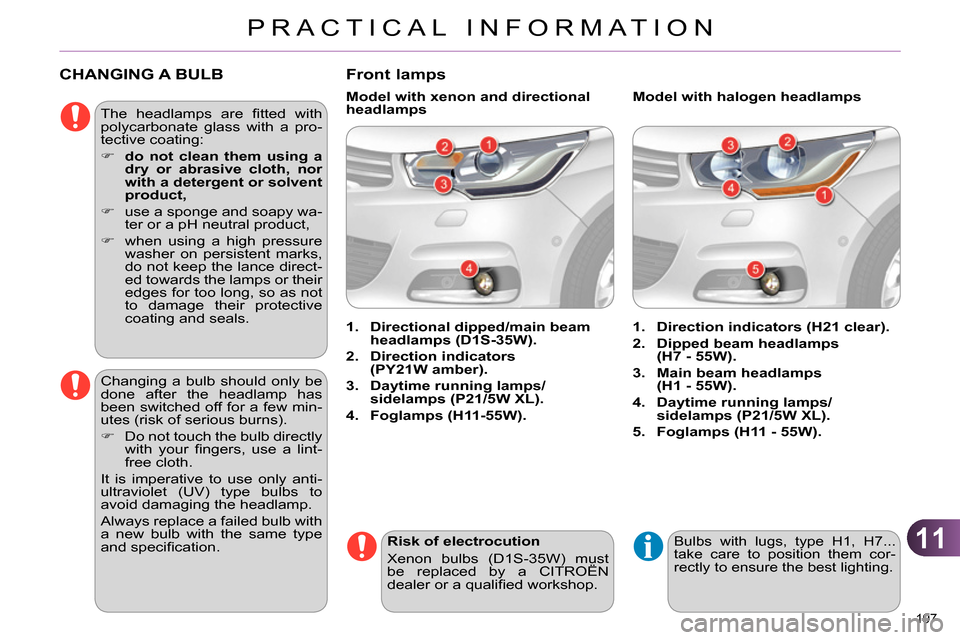
11
PRACTICAL INFORMATION
197
CHANGING A BULB
The headlamps are fi tted with
polycarbonate glass with a pro-
tective coating:
do not clean them using a
dry or abrasive cloth, nor
with a detergent or solvent
product,
use a sponge and soapy wa-
ter or a pH neutral product,
when using a high pressure
washer on persistent marks,
do not keep the lance direct-
ed towards the lamps or their
edges for too long, so as not
to damage their protective
coating and seals.
Changing a bulb should only be
done after the headlamp has
been switched off for a few min-
utes (risk of serious burns).
Do not touch the bulb directly
with your fi ngers, use a lint-
free cloth.
It is imperative to use only anti-
ultraviolet (UV) type bulbs to
avoid damaging the headlamp.
Always replace a failed bulb with
a new bulb with the same type
and specifi cation.
Risk of electrocution
Xenon bulbs (D1S-35W) must
be replaced by a CITROËN
dealer or a qualifi ed workshop.
Front lamps
1.
Direction indicators (H21 clear).
2.
Dipped beam headlamps
(H7 - 55W).
3.
Main beam headlamps
(H1 - 55W).
4.
Daytime running lamps/
sidelamps (P21/5W XL).
5.
Foglamps (H11 - 55W).
1.
Directional dipped/main beam
headlamps (D1S-35W).
2.
Direction indicators
(PY21W amber).
3.
Daytime running lamps/
sidelamps (P21/5W XL).
4.
Foglamps (H11-55W).
Model with halogen headlamps
Model with xenon and directional
headlamps
Bulbs with lugs, type H1, H7...
take care to position them cor-
rectly to ensure the best lighting.
Page 200 of 328

11
PRACTICAL INFORMATION
198
Amber coloured bulbs, such as
the direction indicators, must be
replaced with bulbs of identical
specifi cations and colour.
When refi tting, close the protec-
tive cover carefully to preserve
the sealing of the headlamp.
Changing direction indicator bulbs
Model with halogen headlamps
Rapid fl ashing of the direction
indicator warning lamp (right
or left) indicates the failure of a
bulb on that side.
Access to bulbs
Remove the air defl ector by unclip-
ping each of its three attachment
points.
Unclip the bonnet release cable at
its two fi xings.
Move the cable down.
After changing the failed bulb, remember
to put everything back in place (cable and
air defl ector). Depending on the engine and only on
the left hand side, you must fi rst carry
out the following operations for access
to the protective covers on the bulbs.
Turn the bulb holder a quarter of a
turn and extract it.
Pull out the bulb and change it.
To reassemble, carry out these opera-
tions in reverse order.
Model with Xenon headlamps
Remove the protective cover by
pulling on its tongue.
Disconnect the electrical connector.
Separate the springs to release the
bulb.
Pull the bulb out and replace it.
To reassemble, carry out these opera-
tions in reverse order.